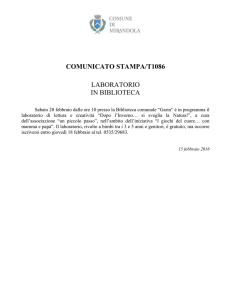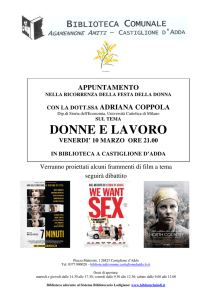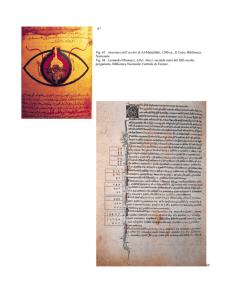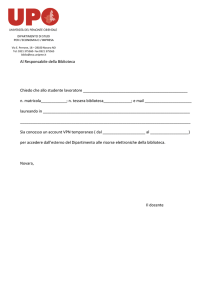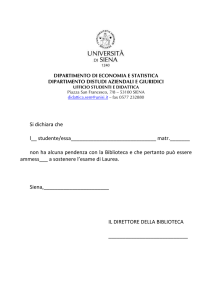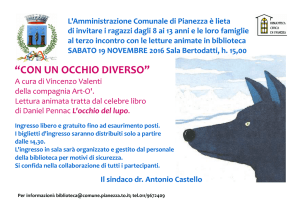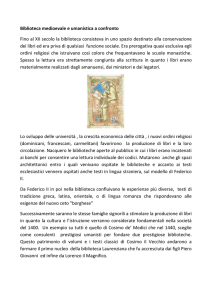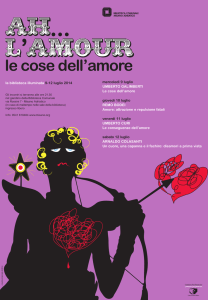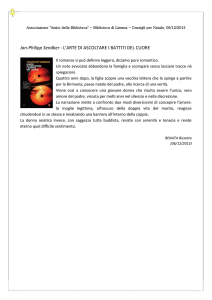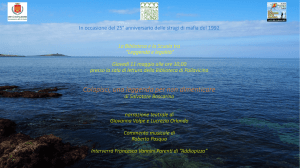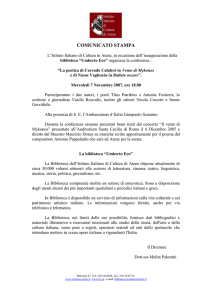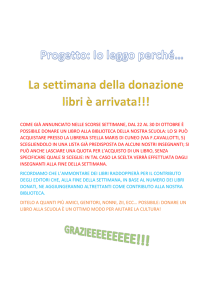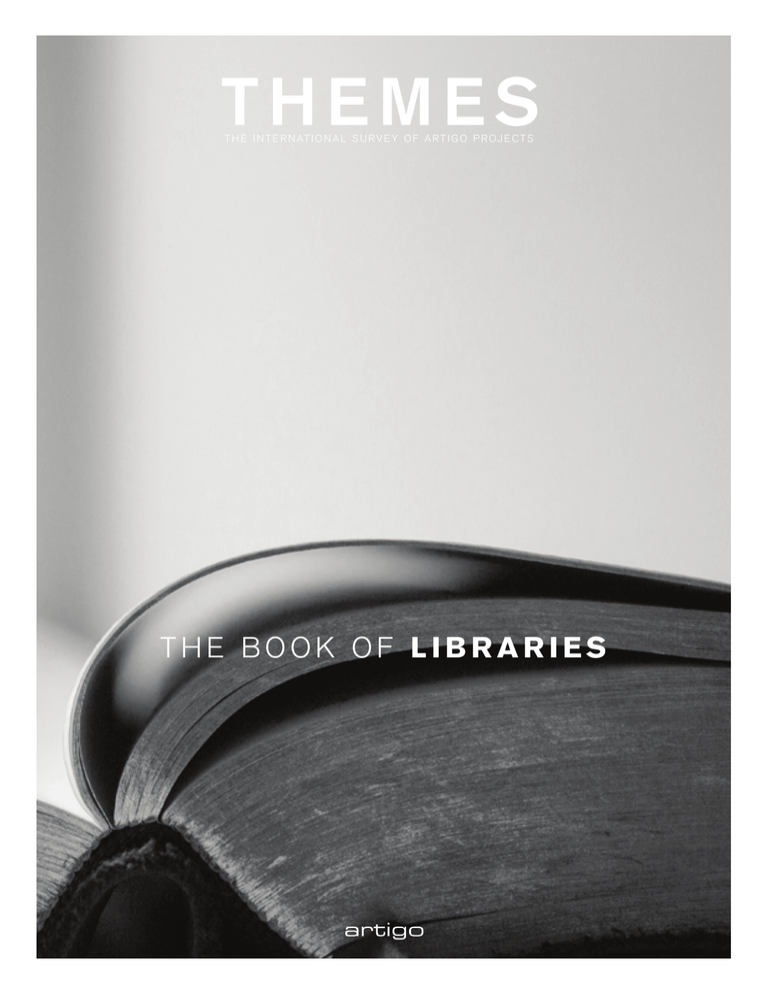
THEMES
T H E I N T E R N AT I O N A L S U R V E Y O F A R T I G O P R O J E C T S
THE BOOK OF LIBRARIES
1
“ C o m e a n d ta k e c h o ice
o f all m y librar y,
A n d s o be g u ile t h y s o rr o w ”
william shakespeare
THEMES
T H E I N T E R N AT I O N A L S U R V E Y O F A R T I G O P R O J E C T S
04 Campus Luigi Einaudi TURIN
08 Médiathèque L’Echo Kremlin-Bicêtre
12 Københavns Universitet Royal Library COPENHAGEN
THE BOOK OF LIBRARIES
18 UNIVERSITY LIBRARY LEIDEN
24 Bibliothèque de la faculté d’Assas PARIS
28 MEDIATHEQUE BORIS VIAN TREMBLAY-EN-FRANCE
32 PUBLIC LIBRARY LABIN
CAmpuS LuIgI EInAudI LIBRARY
4
T U R I N C A m E R A n A & pA R t n E R S
5
6
Nel 2013 la città di Torino si è riappropriata
di una parte importante del proprio passato
industriale, convertendo un’area in disuso, ricca
di storia, in una nuova sede per l’Università.
Il progetto, diretto da Foster & Partners, crea una
struttura avveniristica che ospita la sede della Scuola
di Scienze Giuridiche, Politiche ed Economico-Sociali
e i relativi dipartimenti.
Nell’epoca della grande industria torinese le rive della
Dora (a poca distanza dal monumento-simbolo della
città, la Mole Antonelliana) ospitavano la sede della
Italgas. Oggi è un complesso di edifici immersi nel
verde, dedicati al secondo Presidente della Repubblica
Italiana e immaginati da Norman Foster “come
un’interpretazione moderna del chiostro, formato da
due edifici collegati da un tetto a vela e organizzati
intorno ad un cortile centrale”.
La superficie totale del complesso, inserito dalla
CNN nella propria classifica dei 10 edifici universitari
più belli del mondo, è di 45.000 mq, di cui 36.000
occupati da edifici.
Fra questi, di particolare interesse è la Biblioteca
dedicata al filosofo Norberto Bobbio, progettata dallo
studio Camerana & Partners. Con una superficie di
10.000 mq, i suoi 26 km di scaffali ospitano 600.000
volumi. È proprio nella Biblioteca che si è concentrato
il nostro lavoro, con la fornitura del pavimento in
gomma Nd/Uni: l’ampia varietà cromatica della
collezione ha permesso di identificare ogni piano
dell’edificio con un colore diverso.
Il nostro contributo al progetto comprende anche
le pavimentazioni per le aule, le sale conferenza,
gli uffici e le monumentali scale che caratterizzano
l’architettura dell’edificio.
C A MPU S L U I G I E I N A UD I
TURIN
C A M E R A N A & PA R TN E R S
Rediscovering, reclaiming, repurposing: in an
post-industrial area, rich with history, the project
masterminded by Foster & Partners creates a
new “home for learning” for our times and for
times to come. In the times of heavy industry, the
banks of the Dora river in Turin were the home of
the Italgas factory. From 2013 knowledge flourishes
in the new Luigi Einaudi Campus (named after
the second President of the Italian Republic), a
department of the University of Turin. “The design”,
in the words of the world-renowned architects, “is
a modern interpretation of the traditional cloistered
quadrangle, formed of two linked buildings, unified
by a single roof canopy and arranged around
a central courtyard”.
The total surface of the complex, included by CNN
in 2014 in its own “World’s 10 most spectacular
University buildings”, is 45.000 sqm, 36.000 of which
are occupied by buildings. Among these, of particular
interest is the Library dedicated to philosopher
Norberto Bobbio, designed by Camerana & Partners
studio. With a surface of 10.000 sqm, 26 km of
shelves house more than 600.000 volumes.
The Library has been the focus of our work as well,
providing Nd/Uni flooring in a wide variety of shades,
identifying each floor of the building thanks to the
different colors.
As is customary in our approach, we also provided
flooring for the classes, the conference rooms, the
offices and all the stairs.
7
M é d iat h è q u e L’ E c h o P A R I S
8
K - arc h i t ec t s
9
“Una mediateca non è soggetta al rigore
architettonico tipico di una biblioteca. Il suo
ruolo è più aperto e può pertanto esprimere
un’immagine più spettacolare. In altre parole,
questo edificio può e deve generare il desiderio
di entrarci”. Le parole dei designers Karine
Herman & Jérôme Sigwalt dello studio K-architects
definiscono subito come L’Echo sia molto di più di
una semplice mediateca di quartiere, associando
un forte senso di appartenenza e di dedizione alla
propria missione culturale con un approccio più
contemporaneo verso le modalità con cui la cultura
viene vissuta e condivisa oggi.
Un edificio iconico, grazie alla sua faccia in “Rosso
Ferrari”, nel comune di Le Kremlin-Bicêtre, a sud di
Parigi, è un luogo che veramente invita alla curiosità
e all’esplorazione. Il tutto con uno stile “easy”, che
permette a tutti i visitatori, giovani e adulti, di frequentare
il luogo con familiarità. La mediateca propone inoltre
un ricco calendario di eventi, attività e recensioni,
assumendo così un ruolo attivo nella diffusione di
contenuti culturali verso la propria comunità.
Un progetto che si muove attivamente per abbattare
i muri che ancora separano la cultura dal pubblico
più ampio, facendo di tutto per renderla fruibile e
attraente: L’Echo utilizza il nostro classico pavimento
monocolore Nd/Uni: una scelta che dal punto di vista
estetico ben si adatta alle ispirazioni post-industriali del
progetto, con in più le garanzie di sicurezza e riduzione
del rumore da calpestio tipiche delle nostre collezioni.
M é d iat h è q u e L’ E c h o
PARIS
K - arc h i t ec t s
“A media library does not have the rigor of a
simple library. Its appearance is more open and
can express a more spectacular image. In other
words, this building can and must generate
desire”. In the words of designers Karine Herman &
Jérôme Sigwalt of K-architects, L’Echo is more than
your typical neighborhood “mediateque”, combining
a strong sense of mission and commitment to
knowledge with a contemporary approach to sharing
and “consuming” culture. An iconic presence (thanks
to its “rosso Ferrari” facade) in the commune of Le
Kremlin-Bicêtre, just south of Paris, it is a place that
invites curiosity, discovery and exploration, while at
the same time retaining an “easy” style, allowing all
10
visitors, young and grown-ups, to relax, sit back and
just feel free to browse through books, magazines,
music and movies. Compliant to its mission, the
mediateque proposes a full and varied calendar of
events, recommendations, activities and reviews,
establishing itself as a beacon of “good” culture for
the people of the commune: vibrant, alive, friendly.
There may be a lot of walls to tear down when it
comes to ensuring the fruition and the enjoinment
of culture in nowadays world: the reclusive, selfreferential notion of serious culture allegedly opposed
to popular (or pop) culture has to go, and this project
in Paris, where we supplied our classic solid-colour
Nd/Uni, is certainly a very good start.
11
R OYA L L I B R A R Y C O P E N H A G E N
12
D I S S I NG + W E I T L I NG
13
Fondata nel 1479, la Facoltà di Studi
Umanistici della Københavns Universitet è una
la più grande, nonchè una delle più antiche
dell’Europa del nord. Un punto di riferimento
culturale di grande importanza, con più di 12.000
studenti iscritti e 50 corsi di laurea, che nel 2008 ha
visto il completamento della propria nuova sede presso
il campus Amager, nella zona sud di Copenhagen.
Nel 2015 lo stesso South Campus si è convertito
in un vero e proprio hub destinato a diventare un
punto di incontro fra tecnologia, arte, new media,
istituzioni e mondo professionale, con l’accorpamento
delle facoltà Umaniste, di Legge e di Teologia e una
porzione della facoltà di Scienze.
Progettata dallo studio Dissing+Weitling con l’obiettivo
di “creare spazi ottimali per le attività umane”, la
Kongelige Bibliotek è concepita per essere nello
stesso tempo luogo di studio e archivio storico.
Un’architettura di ampio respiro, con 500 postazioni di
lettura e un totale di 73 km di scaffali, scandita da un
vero e proprio percorso che parte dalle aree dedicate
alla socializzazione, come la cafeteria, per salire
progressivamente verso gli spazi dedicati allo studio
individuale, nei quali è stato possibile garantire, grazie
anche ai 3000 mq di pavimentazione in gomma Artigo
(in questo caso il nostro Nd/Uni nel colore U17),
la massima silenziosità.
R OYA L L I B R A R Y
COPENHAGEN
D I S S I NG + W E I T L I NG
Founded in 1479, the Faculty of Humanities of
the Københavns Universitet is the largest and
one of the oldest in Northern Europe.
A cultural landmark of great importance, with over
12.000 students and 50 graduate courses, which in
2008 saw the completion of its headquarters at the
Amager campus in the south of Copenhagen.
By 2015, the South Campus became a hub from
which technology, art, culture and media can
interact with the business sector and institutions: the
University of Copenhagen has grouped all of the units
of the Faculties of Humanities, Law and Theology as
well as a small proportion of the Faculty of Science
14
on South Campus. Designed by Dissing+Weitling
with the aim to “create optimal spaces for human
activities”, the Kongelige Bibliotek is designed to be
both a place of study and historical archive.
A broad architecture, with 500 reading stations and a
total of 73 km of shelving, marked by an actual path
that starts from areas devoted to socialisation, such as
the cafeteria, rising gradually to the spaces dedicated
to individual studies, in which it was possible to ensure
maximum silence thanks to the Artigo rubber flooring:
in this case, we provided more than 3.000 sqm of our
Nd/Uni flooring, in the U17 shade.
15
F E AT U R E S F O R L I B R A R I E S
A B E TT E R QU A L I TY OF A I R
Una migliore qualità dell’aria interna, per una
pavimentazione che rispetta l’ambiente.
Le pavimentazioni Artigo rispondono alle più rigorose
specifiche ambientali: si possono fregiare delle più
importanti certificazioni ecologiche europee
(Blue Angel in Germania e M1 in Finlandia) e
Americane (Greenguard Gold) contribuiscono alla
creazione di interni più sani e qualificano
per i crediti LEED e BREEAM sulla sostenibilità
degli edifici.
Artigo è da sempre impegnata nel garantire un
corretto approccio industriale eco-sostenibile:
le linee di produzione di Cairo Montenotte sono
alimentate per oltre il 10% da energia fotovoltaica.
16
La gomma è ottenuta dal caucciù, estratto da alberi
che non vengono danneggiati dal processo, oppure
dalle code di produzione delle benzine. Al termine
della sua lunghissima “vita”, una pavimentazione in
gomma è assimilabile ad un rifiuto solido urbano e di
facile smaltimento.
La collezione Screed rappresenta un prodotto
d’avanguardia in termini di eco-sostenibilità, in quanto
è prodotto utilizzando il 65% di materiali naturali e
il 10% di rapidamente rinnovabili.
The perfect choice for environment-aware designers:
Artigo floorings are compliant to the most important
environmental certifications both in Europe
(Blue Angel in Germany, M1 in Finland) and
America (Greenguard Gold).
Artigo floorings represent a real contribution to
healthier environments, both in workspaces and in
public buildings. Our products qualify for LEED
and BREEAM credits for green buildings.
At the end of its very long life, rubber flooring
resembles solid urban waste and is, hence, easy
to dispose of. Artigo production lines in Cairo
Montenotte, Italy, are solar-powered for more than
10%. Another example of the eco-friendly approach
that defines every endeavour of the company.
The Screed collection is a state-of-the-art product
in terms of sustainability, produced with 65% of
natural materials and 10% of rapidly renewable
resources.
Rubber is either obtained from trees, which are not
damaged by the process, or from the residue of petrol
production.
17
u n I v E R S I t y L I B R A Ry L E I D E N
18
k At j A h o g E n B o o m S t u d I o
19
Come si affronta il redesign di una biblioteca
fondata nel XVI secolo? Come si può prestare
orecchio, oggi, alle storie contenute in 5 milioni
di volumi? Che posto hanno, nel nostro mondo
digitale, due manoscritti antichi iscritti nel Memory of
the World Register dell’Unesco?
Per Katja Hogenboom, uno degli architetti che si
è occupato della ristrutturazione della Biblioteca
dell’Università di Leiden, la risposta è chiara:
“Al pubblico piace frequentare la nuova Biblioteca
perchè le strade sono ormai riservate allo shopping
e agli spostamenti casa-ufficio. Edifici pubblici come
questo possono diventare il nuovo volto pubblico della
città, fonte di informazioni e di cultura”.
La biblioteca come una moderna agorà, un luogo di
incontro, studio e condivisione. In perfetta sintonia con
i nostri tempi, con un milione di e-book sugli scaffali
virtuali. La Biblioteca è a disposizione degli studenti
dell’Università, ma anche il grande pubblico può
accedervi.
L’area studi del primo piano è dove il nostro contributo
al progetto si è concretizzato, con la fornitura
del nostro esclusivo pavimento in gomma Kayar,
disegnato da Sottsass Associati. Caratterizzato dalle
fibre di cocco naturale distribuite casualmente sulla
superficie, Kayar è un progetto che riflette l’ispirazione
orientale che ha sempre accompagnato Ettore
Sottsass (“Kayar” è il nome delle corde in fibra di
canapa in lingua Tamil). Un Oriente che è fortemente
presente anche nella UBL, con una famosa collezione
di libri orientali che comprende 30.000 manoscritti
e 200.000 libri.
UN I V E R S I TY L I B R A R Y
LEIDEN
Kat j a H o g e n b o o m s t u d i o
How do you approach the redesign of a Library
that goes back to the XVI century? How do
you listen to the stories told by more than 5
millions volumes? What kind of place hold ancient
manuscripts, including two inscribed in the Unesco
Memory of the World Register, in today’s digital world?
For Katja Hogenboom, one of the architects working
on renovation of the Leiden University Library, the
answer is quite clear. “People like to go to this new
library to read and meet, now that the streets of the
city are taken over by shopping and commuting.
Public buildings such as this can provide information
and enlightenment when they become the new public
sphere of the city”.
20
A library like a modern-day agorà, a place of meeting,
studying, sharing. Perfectly attuned to the modern
age, with one million e-books on its virtual shelves,
the Library focuses its mission mainly towers the
students of Leiden University, though others can profit
from its services. For the redesign of the 1st floor
study area we provided our exclusive Kayar flooring
with coconut fibers, designed by Sottsass Associati.
Kayar is a product inspired by the asian world (“Kayar”
means coconut-fibre rope in Tamil), a world in which
the UBL also holds a strong expertise, with a renewed
oriental collection that contains 30.000 manuscripts
and 200.000 books.
21
F E AT U R E S F O R L I B R A R I E S
S I L E NT, R E S I L I E NT A ND S A F E
22
I pavimenti in gomma Artigo garantiscono
un’eccezionale riduzione del rumore da
calpestio e pertanto rappresentano una soluzione
ideale per gli asili. Una pavimentazione in gomma
di spessore 3 mm offre una riduzione fino a
10db, che a pari spessore è superiore a tutti gli altri
pavimenti resilienti. La nostra proposta esclusiva
Granito Acoustic garantisce una riduzione fino a
20 db.
I trattamenti superficiali Artigo Pro e TXL permettono
di ridurre significativamente i costi di gestione.
PRO: spalmatura di un coating polimerico di
ultima generazione che protegge la superficie
incrementandone le performance, migliorandone la
pulibilità e non rendendo necessaria la prima ceratura.
TXL: intervento di postvulcanizzazione che aumenta la
densità del materiale, ottenendo una minore porosità
della superficie.
La resilienza delle pavimentazioni in gomma Artigo
- e di conseguenza la loro durata nel tempo - è
testimoniata da un’ampia casistica che include
casi di eccellenza assoluta, come i pavimenti e
le pensiline della linea 1 della Metropolitana
Milanese, progettata da Franco Albini all’inizio degli
anni sessanta.
La gomma rappresenta il materiale anti-scivolo
per definizione: le pavimentazioni Artigo sono
classificate R9 (la collezione Lava è classificata
R10) secondo la norma europea DIN 51130 che
determina le proprietà antisdrucciolevoli dei materiali
per pavimenti.
Artigo floors ensure considerable reduction of noise
due to treading, proving to be the ideal solution for
nurseries. A 3 mm-thick floor achives reduction
values up to 10 db, that go up to 20 db with our
exclusive Granito Acoustic collection.
Rubber is the anti-slipping material by definition:
Artigo floorings are classified R9 (Lava collection
is R10) according to DIN 51130, determination of
anti-slip properties.
Resilience is a strong feature of Artigo’s floorings:
durability through time has always been one of our
strong points, with examples that go back to Line 1
of Milan Metro Stations, designed in the 60s by
Franco Albini.
The exclusive surface treatments PRO and TXL
guarantee an even better resistance to staining
and chemical agents, considerably reducing the
level of detergents, water and energy required for
maintenance.
PRO: surface treatment utilising the latest generation
UV linked polymeric coating technology. The coating
finish protects the surface, improves performance.
TXL: Post vulcanization treatment that achieves
a lower surface density whilst increasing surface
resistance, enhancing cleaning, dirt and scratch
resistant properties.
23
L I B R A R y fA C u Lt é d ’ A S S A S P A R I S
24
A L A I n S A R fAt I A R C h I t E C t u R E S
25
26
Fondata nel 1970 come diretta erede
dell’Università di Parigi, un’istituzione con 700
anni di storia, la facoltà di Panthéon-Assas
annovera fra i propri alunni due Presidenti,
quattro Primi Ministri e un gran numero di
giuristi e uomini politici. La Biblioteca della facoltà,
in Rue d’Assas, è stata inaugurata nel 2011.
“Il Preside della facoltà” spiega l’architetto Alain
Sarfati “ci ha chiesto di enfatizzare gli aspetti più
sociali, condivisi, nella vita degli studenti”.
Per questo le aree comuni dell’edificio assumono un
respiro ampio, quasi solenne, ispirando un senso di
comunità, di appartenenza collettiva, e nello stesso
tempo conservando le dimensioni del silenzio
e della concentrazione.
La Biblioteca è aperta 67 ore alla settimana, con
oltre 15.000 volumi a disposizione, permettendo agli
studenti di incontrarsi, socializzare e sentirsi parte
integrante della tradizione e della storia della facoltà.
La monumentale hall rappresenta un “viale interno”
che corre lungo tutto l’edificio, con le finestre alte e il
futuristico soffitto ispirato alle forme delle nuvole.
Tutto è nel dintorno del bianco, così come il nostro
pavimento della collezione Nd/Uni. Una scelta che
assicura la massima riduzione del rumore da calpestio,
in un ambiente ad alta frequentazione in cui tuttavia
ognuno può facilmente trovare il proprio spazio
mentale individuale.
librar y fac u lt é d ’ A ssas
P aris
alai n sar fat i arc h i t ec t u res
Established in 1970 as a direct successor to the
700 years old University of Paris, the faculty of
Panthéon-Assas University has produced so far
two Presidents, four Prime Ministers and a large
number of jurists and politicians.
The Library of the Faculty, located in Rue d’Assas,
retains all the features of such an illustrious place of
knowledge: silence, focus, solemnity, and yet a sense
of community, a feeling of collective experience. It’s a
place open 67 hours every week, where people can
meet, browse through the 15.000 books on loan,
study, socialize and feel integral part of a past that
reverberates into the present.
The monumental hall is the inner avenue that runs
through the building. It conveys a feeling of awe,
with the high windows and the futuristic, cloudshaped ceiling. The colour palette runs through
the most aethereal tones, with warm white as the
primary colour. Our UNi/Nd flooring proved to be a
perfect match for architect Alain Sarfati’s vision: a
fundamental component of the project, the rubber
flooring provided is crucial to guarantee the best noise
reduction, a key aspect to the comfort and dedication
of the large number of students who attend the
Library every day.
Rubber is the perfect material for heavy use floorings
thanks to its resilience and fast, easy cleaning.
Last but not least, the natural hygienic characteristics
of rubber guarantee the best conditions for such a
highly partecipated place.
27
m E d I At h E q u E B o R I S v I A n
28
TREmBLAY-EN-FRANCE B+C ARChItECtS
29
30
“Questa storia è vera, perchè me la sono
inventata”. Romanziere, poeta, cantautore,
musicista jazz, controverso scrittore pulp (con
lo pseudonimo di Vernon Sullivan) e molto altro:
basta il nome di Boris Vian per evocare immagini
di Parigi nell’era del jazz.
ma c’è ancora di più nell’eredità dell’autore de
“La Schiuma dei Giorni”, se a portare il suo nome
(insieme a quello del “collega” surrealista Louis
Aragon) è una mediateca nel comune di Tremblay-enFrance, subito a nord di Parigi.
Il progetto architettonico prende le mosse dal
recupero di un complesso degli anni 80, con
l’obiettivo di trasformarlo in una struttura più utile e
“sociale” per la comunità. Lo studio B+C Architects
ha deciso di adottare uno schema di colori vivaci
“per dare leggibilità e luminosità alle nuove funzioni
dell’edificio”. Il cuore del progetto è rappresentato
dalla sala conferenze con le pareti in vetro, dotata di
50 posti a sedere.
Nella loro ricerca cromatica, gli architetti Giovanni
Bellaviti e Dino Constantin Coursaris hanno trovato
nell’ampia tavolozza della nostra collezione BS la
risposta ideale. Dall’arancione che illumina le sale e
la media room al nero assoluto della sala conferenze,
ideale per proiezioni, ogni ambiente della biblioteca
acquista una propria personalità.
m E d I At h E q u E B o R I S v I A n
T R EmB LAY- E N - F R A N C E
B +C A RC h It E C t S
“This story is true, since I invented it”.
Novelist, poet, songwriter, jazz cat, infamous
pulp author (under the pseudonym of Vernon
Sullivan) and many more things. The name of
Boris Vian conjures images of Jazz-age Paris even
more effectively than Paul Newman’s “Paris Blues”.
But there is a lot more in the legacy of the author
of “L’Écume des jours”, as is suggested by the
mediatheque of Tremblay-en-France carrying his
name, along with that of fellow surrealist artist
Louis Aragon.
The architectural project started as a rehabilitation of
an 1980s building, transforming it into a more “social”
(in every sense of the word) and useful environment
for the community. B+C Architects decided to use
strong colors “to give readability and luminosity to the
new functions” of the place. The literal “heart of glass”
of the project is the 50-seats conference room, with
glass walls, that stadns at the centre of the building.
In a project where color plays an important function,
the wide color range of our iconic BS flooring was the
perfect answer. The studded flooring is a constant
presence in the project, from the bright orange that
brings to life the halls and the media room to the
perfect black floor of the conference room, ideal for
screenings and projections.
31
p u B L I C L I B R A Ry L A B I N
32
SkRoZ ARChItECtS
33
34
Una biblioteca che prende il posto di una
miniera: un altro progetto con delle profonde
radici nel passato. La Biblioteca pubblica della città
di Albona, in Croazia, era una miniera attiva fino alla
fine degli anni 80. “In quel periodo l’attività mineraria
cessò, ma le strutture e gli edifici furono preservati
come esempi di architettura industriale” spiegano
Ivana Žalac e Margita Grubiša dello studio
di architettura Skroz.
Alla storia della biblioteca si aggiunge anche un
progetto architettonico utopistico: quello della città
sotterranea, che nel corso degli anni si modifica fino
a diventare la visione di un centro culturale di cui
l’attuale biblioteca è solo la prima fase.
I volumi sono alloggiati nella “Grande Sala di Marmo”:
quella che un tempo era la sala comune in cui i
minatori ritiravano le paghe. “Abbiamo cercato”
illustrano ancora gli architetti di Skroz, “di valorizzare
la spazialità della sala e la sua luminosità. Per questo
abbiamo scelto uno schema colori esclusivamente
basato sui neutri e in particolare sul bianco per ogni
elemento, dai mobili alle pareti fino al pavimento”.
Il pavimento in questione è della nostra collezione
Kayar, disegnata da Sottsass Associati: non un bianco
perfetto, data la presenza delle fibre di cocco: più un
neutro che, grazie alla propria texture, aggiunge una
nota di “fisicità” alla sala. Da non dimenticare poi che,
grazie alla sua morbidezza, si è rivelato ideale anche
per l’area dedicata ai bambini.
Il progetto ha partecipato al Mies Van Der Rohe
EU Prize for Contemporary Architecture nel 2015.
La motivazione della giuria recita: “L’approccio del
progetto è a tutti gli effetti un’analisi della storia dello
spazio e di tutte le fasi della sua esistenza. La sua
sostenibilità è basata sul ri-uso totale dell’esistente,
senza introdurre alcuna nuova costruzione”.
PU B L I C L I B R A R Y
LABIN
SKROZ ARCHITECTS
Another library that shares its roots with an
ancient past. This used to be a mining complex,
active until the late 80s.
“The actual mine was shut down, but the above
ground industrial buildings were protected, as valuable
examples of industrial heritage” say architects Ivana
Žalac and Margita Grubiša of Skroz.
The story of preservation and reuse goes through
many a twists, including the idea of an underground
city that was turned into a cultural complex, of which
this library is only phase one.
“The great Marble Hall” houses the library: it used
to be the place where once paychecks would be
picked. According to Skroz, “the project tries to show
its spaciousness, its grandeur and quality of natural
light. In terms of color, the new project pays respect
to the existing environment by choosing exclusively
light and/or white shelves, walls, furniture, equipment
and floor finish”. The floor in case is our own Kayar,
designed by Sottsass Associati: not a perfect white,
since it features natural coconut fibers, but its subtle
texture adds more depth to the scheme, and thanks
to its softness, it proved the perfect choice for the
children’s play area.
The project has been nominated for the Mies Van
Der Rohe EU Prize for Contemporary Architecture
in 2015, with a motivation that states: “The design
approach is indeed a commentary on the history
of the space and on all the phases of the mine’s
existence. The sustainability of the building is based
on the re-use factor; no new spatial resources are
being built. In spite of the pressures from tourism and
commercialization, the project’s priority has remained
the local public interest”.
35
A R T I G O S PA
Via Cascina Vione 3
20080 Basiglio (Mi)
Te l + 3 9 0 2 9 0 7 8 6 4 1 5
Fax +39 0290786449
ARTIGO FRANCE SARL
Rue Armand Carrel
93100 Montreuil
Te l + 3 3 1 4 8 1 8 0 0 0 7
Fax +33 148180716
ARTIGO IBERICA SL
Profesor Beltran Baguena 4
4 6 0 0 9 Va l e n c i a
Te l + 3 4 9 6 3 4 9 8 8 9 9
Fax +39 963498713
DOWNLOAD OTHER
ISSUES OF THEMES FROM
WWW. A R T I GO . C OM
THEMES
T H E I N T E R N AT I O N A L S U R V E Y O F A R T I G O P R O J E C T S
38

